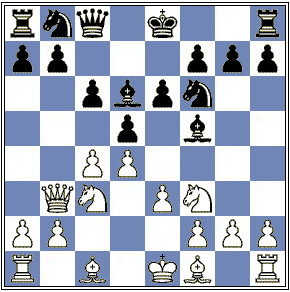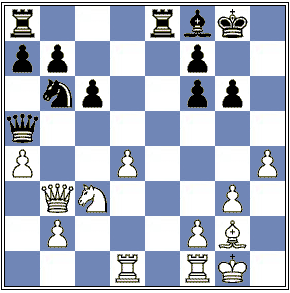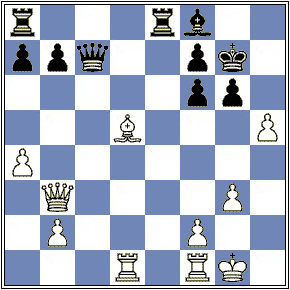
|
Yaacov Norowitz Lecture on Color Complexes
On Thursday, December 10, 2009, Kenilworth Chess Club champion SM Yaacov Norowitz (recent winner of the World Open blitz event and member of the winning New York Knights US Chess League team) gave a lecture at the Kenilworth Chess Club on “color complexes” (also called “square strategy”) and the way players can use the concept to help guide their decision making during the game. The concept of color complexes seems especially valuable in blitz play, where the idea of balancing control of black and white squares can yield an almost instant barometer of how you stand positionally and be translated quickly into strategy and action. Yaacov showed two games as the focal point of his lecture, which we reproduce below with some notes suggestive of the points he made.
Game One
Yaacov Norowitz – NN [D00]
New York/New York, NY 2009
An unusual way for White to head toward the Stonewall formation with f4, laying claim to the dark squares with pawns so that he can build on light with pieces. The idea behind this move is to discourage Black from countering White’s dark-square control with c5 when White wins and keeps the pawn with dxc5 and b4.
3… Bf5
Not being able to counter on dark, Black fights to control the light squares.
4. Qb3
Exploiting the Bishop’s absence to gain time for a counter.
4… Qc8
4… b6!? seems to weaken the light squares too much, but a recent USCL game shows that Black can make it work by building on light to compensate: 5. c4 e6 6. Nc3 Be7 7. Nf3 h6 8. g3  Qb8 27. b4 Nb3 28. Rxc8 Qxc8 29. Bxb3? (29. Qb2! Bc2 30. Bb7!
Qb8 27. b4 Nb3 28. Rxc8 Qxc8 29. Bxb3? (29. Qb2! Bc2 30. Bb7! )
29… Rxd4 30. Bxd4 Bf5 31. Ne3 Be6 32. Bc2 g6 33. Be4 a5 34. Bxb6 axb4 35. axb4 Qb8 36. Ba5 Qb5 37. Nd5 Bxd5 38. Bxd5 Qe2 39. Rf1 Qd2 40. Bg2 Bxb4 41. Bxb4 Qxb4 42. h4 Kg7 43. Kh2 Qd2 44. Kh3 Qe2 45. Rb1 g5 46. Rf1 Kf8 47. Kh2 gxh4 48. gxh4 Qg4 49. Bh3 Qxh4 50. f5 Qe4 51. e6 h5 52. exf7 h4 53. Bg2 Qe5+ 54. Kh1 Qg3 55. Rf3 Qg4 56. f6 Kxf7 57. Rf1 Qd4 58. Rf3 Qd1+ 59. Rf1 Qd4 60. Rf3 Qe5 61. Kg1 Qg5 62. Kh1 Qh5 63. Kg1 h3 64. Rxh3 Qd1+ 65. Kh2 Kxf6 66. Rf3+ Kg5 67. Rh3 Qe1 68. Rf3 Kg4 69. Rh3 Game drawn by mutual agreement 1/2-1/2 Norowitz,Y (2354)-Defibaugh,J (2155)/Internet Chess Club 2009.
)
29… Rxd4 30. Bxd4 Bf5 31. Ne3 Be6 32. Bc2 g6 33. Be4 a5 34. Bxb6 axb4 35. axb4 Qb8 36. Ba5 Qb5 37. Nd5 Bxd5 38. Bxd5 Qe2 39. Rf1 Qd2 40. Bg2 Bxb4 41. Bxb4 Qxb4 42. h4 Kg7 43. Kh2 Qd2 44. Kh3 Qe2 45. Rb1 g5 46. Rf1 Kf8 47. Kh2 gxh4 48. gxh4 Qg4 49. Bh3 Qxh4 50. f5 Qe4 51. e6 h5 52. exf7 h4 53. Bg2 Qe5+ 54. Kh1 Qg3 55. Rf3 Qg4 56. f6 Kxf7 57. Rf1 Qd4 58. Rf3 Qd1+ 59. Rf1 Qd4 60. Rf3 Qe5 61. Kg1 Qg5 62. Kh1 Qh5 63. Kg1 h3 64. Rxh3 Qd1+ 65. Kh2 Kxf6 66. Rf3+ Kg5 67. Rh3 Qe1 68. Rf3 Kg4 69. Rh3 Game drawn by mutual agreement 1/2-1/2 Norowitz,Y (2354)-Defibaugh,J (2155)/Internet Chess Club 2009.
5. c4!
With Black laying claim to light squares, White must switch up his strategy and fight back on light.
Now how should White continue to try to fight for light?

How should White fight for the light?
An interesting alternative is 8… Bg4 9. h3 Bh5 10. g4 Bg6 11. Nxg6 hxg6 12. Bg2 which would yield a different color balance.
Blocking Black’s pressure on dark square h2 by building on dark. White also posts his “golden Bishop” on its best diagonal and plays to make that Bishop happy.
10… Nbd7 11. Bg2
Disrespecting the power of the golden Bishop, Black mistakenly surrenders light squares and gives the Bishop more scope on the long diagonal.
This was Black’s plan: to liquidate the center in Colle style. But now White gains the possibility of d5, breaking through on light.
14. Bd2 exd4 15. exd4!? Nb6 16. Qb3 Rd8 17. Rad1 Bf8
18. Bg5!
The dark squared Bishop assists in the fight for the light square d5 by attacking a key light-square protector in Black’s camp.
18… Qf5 19. h4! Re8 20. a4 Qa5?!
The queen is clearly misplaced here. White now breaks through decisively. Not much better is 20… Rab8 21. Bf4 and a5.
and a5.

How can White maximize his light square power?
The threat of Nxf6+ forced the issue.
24. Bxd5!
The Golden Bishop assumes its ideal position, holding complete sway over the light squares and eyeing targets on both sides of the board. The alternative 24. Rxd5!? Qc7 25. h5 is also strong, when the bishop’s latent power is still felt.
A neat conclusion would have been possible after 25… Kg7?

White to play and win, attacking light and dark.
26. Bxf7!! Qxf7 27. h6+ Kg8 28. h7+ Kg7 29. h8=Q+!
The King make s way for White’s only inactive piece, the Rook at f1, which now joins the attack along the h-file.
|
29. Bxf7+! Kxf7 30. Qxb7+ Be7 31. Qxa8 Re2 32. Qd5+
and Black soon resigned. The concluding combination naturally takes place on light squares with the golden Bishop in the lead.
1-0
Game Two
R-Kasimdzhanov – YaacovN [A45]
ICC 3 0 u/Internet Chess Club 2006
The following game was played with the FIDE World Champion Rustam Kasimdzhanov on ICC at 3 minutes each, no increment.
It is interesting to see how Kasimdzanov has played the position as Black: 2… g6 3. Bxf6 exf6 4. g3 f5 5. Bg2 Bg7 6. e3 (and White has put his pawns on dark to compensate for the loss of the Bishop and continues to fight for dark squares with pawn moves like h4 and b4.) 6…  )
16… Qd8! 17. Nh5 Bh6 18. gxh4 c6 19. Ndf4 Qxh4 20. Qh3 Qg5 21. Kh1 Bd7 22. Bf3 Kf8 23. c5 Ke7! 24. cxd6+ Kxd6 25. d5 Rh8 26. Bxg4? fxg4 (26… Qxg4!)
27. Qg3 Qe5 28. Kg2 Qe4+ 29. Kg1 Bxf4 30. Qxf4+ Qxf4 31. Nxf4 cxd5
)
16… Qd8! 17. Nh5 Bh6 18. gxh4 c6 19. Ndf4 Qxh4 20. Qh3 Qg5 21. Kh1 Bd7 22. Bf3 Kf8 23. c5 Ke7! 24. cxd6+ Kxd6 25. d5 Rh8 26. Bxg4? fxg4 (26… Qxg4!)
27. Qg3 Qe5 28. Kg2 Qe4+ 29. Kg1 Bxf4 30. Qxf4+ Qxf4 31. Nxf4 cxd5 32. Kg2 Bf5 33. Kg3 Be4 34. Rad1 f5 35. Rxd5+ Bxd5 36. Rd1 Rh3+ 37. Nxh3 gxh3 38. Kxh3 Ke5 39. Kg3 Rg8+ 40. Kh3 Bxa2 41. Rd7 Bd5 42. Kh4 Rg4+ 43. Kh5 Rxb4 44. f4+ Ke4 45. Kg5 Be6 46. Re7 Rb6 47. Kf6 a5 48. Kg7 a4 49. Kh8 a3 50. Rc7 a2 51. Rc1 Rb1 White resigns 0-1 Ubiyca (3397)-R-Kasimdzhanov (3440)/Internet Chess Club 2006.
32. Kg2 Bf5 33. Kg3 Be4 34. Rad1 f5 35. Rxd5+ Bxd5 36. Rd1 Rh3+ 37. Nxh3 gxh3 38. Kxh3 Ke5 39. Kg3 Rg8+ 40. Kh3 Bxa2 41. Rd7 Bd5 42. Kh4 Rg4+ 43. Kh5 Rxb4 44. f4+ Ke4 45. Kg5 Be6 46. Re7 Rb6 47. Kf6 a5 48. Kg7 a4 49. Kh8 a3 50. Rc7 a2 51. Rc1 Rb1 White resigns 0-1 Ubiyca (3397)-R-Kasimdzhanov (3440)/Internet Chess Club 2006.
4. f3 Nf6 5. e4 dxe4 6. Nc3 is sometimes played, with the idea that White has a tempo over the standard Blackmar Diemer Gambit. Perhaps one way of seeing the gambit is as an attempt to use White’s strength on dark squares to grab the light squares also.
|
White has built on dark, and Black on light. Now both players play to restore the balance.
Trading the Bishop on the opposite color of your pawns seems to violate square strategy, but fighting for dark squares is important.
9. c4
The trade of Knight for Bishop is a mixed bag: White gains a “golden Bishop” on light and more control of light squares, but Black gains the Knights control of dark squares and moves a pawn toward the center on light to partlially compensate for the Bishop.
13. Nd2 Nbd7 14. c5!? Qc7 15. f4
These moves make sense by the logic of square strategy: White builds on dark because he is strong on light. But Black has some tactical resources to counterattack on dark while maintaining his contol of light with pawns and soon with Knights as well.
15… a5!
Stopping b4 and possibly planning b6 to confront the c-pawn. White’s next stops b6 but allows a different dark-square shot.
16. Rac1
How can Black battle back on dark squares?
|
17. fxg5?! Ng4 18. Rf4 Nxe3 19. Bh7+ Kh8 20. Rh4!? Nxc2 21. Bxc2+ Kg8 22. Bh7+=
17… gxf4 18. exf4 b6! 19. cxb6 Qxb6
With a series of dark square shots (which continues with c5), Black has successfully countered White’s attempt to grab both light and dark squares. He now uses the initiative to grab both light and dark for advantage.
20. Nf3 c5! 21. b3 cxd4 22. Kh1 Nc5
22… Ng4 23. Bb1 Ne3 24. Qd3 Nf6 25. Rfe1 Nf5 26. Qd2
Black has won the battle for squares and his attack now relies on pressure down the a- and b-file toward White’s pawns on light and along the a7-g1 diagonal (with ideas like Ne4-f2+) exploiting his greater control of dark squares due to his two Knights and well-positioned Queen.
24. Bc2 Nce4! 25. bxa4 Rfc8 26. Bxe4 Nxe4 27. Rb1 Qa7! 28. Rb4 Rc4!
White fights to hold the critical d4 square, but Black’s pieces are well positioned to win the battle.
29. a3
29… Qc5!?
29… Rac8!
|
Black’s pawns abreast in the center signal that he has won the war for light and dark. White only has some cheap shots left.
33. Nc6 Qc5 34. Ne7+ Kf8 35. f6 gxf6 36. Nf5 Nf2+ 37. Rxf2 Qxf2 38. Qb1 e4 39. Ng3 Qc5 40. h3 Qxa5 41. Qc1 Qa1 42. Qxa1 Rxa1+ 43. Kh2 Ke7 44. Ne2 Kd6 45. Nd4 Kc5 46. Nb5 Kxb5 47. h4 Ra8 48. Kg3 d4 49. Kf4 d3 50. Kxe4 d2 51. Kf5 d1=Q 52. Kxf6 Qd6+ 53. Kxf7 Rf8+ 54. Kg7 Qf6+ 55. Kh7 Rh8#
White checkmated
0-1













